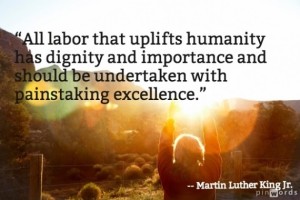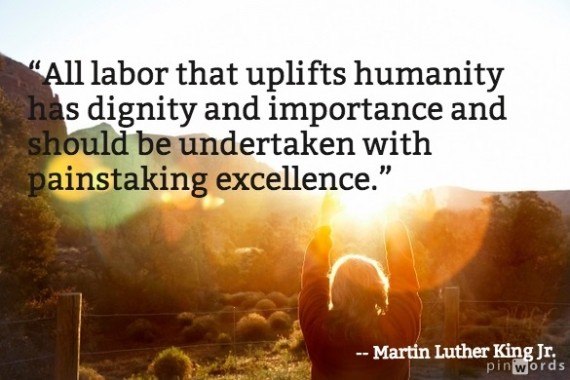 Yes, I am working on Labor Day and loving it! That is one of the joys of being an entrepreneur — we get to choose when, how and why we do our work. Today, I am working only on projects that promote my commitment to economic empowerment for women and girls around the world.
Yes, I am working on Labor Day and loving it! That is one of the joys of being an entrepreneur — we get to choose when, how and why we do our work. Today, I am working only on projects that promote my commitment to economic empowerment for women and girls around the world.
Yet I am mindful of all the workers who do not have that luxury of choice. On my morning dog walk, I ran into a motley crew of people already on the job at 7:30 a.m. — the WalMart employee sweeping the street in front of the store, delivery drivers making sure the store was stocked for one of the biggest shopping holidays, personal care workers starting their shift at the residential care facility next door, the barista who served my morning latte, bus drivers delivering all the forgotten service people who serve our needs on this official labor holiday.
There is a lot to celebrate on this Labor Day holiday. We have laws that prohibit child labor, ensure a minimum wage and minimally decent working conditions, and provide insurance to people who are laid off or injured on the job. We owe that to the courage of all the women and men who risked their jobs and their lives to start labor unions, protest unfair labor practices, and demand basic human rights for workers.
But there is still a long way to go before we can declare economic justice for all workers. According to the Economic Policy Institute, the benefits of the economic recovery have not reached many Americans in important ways:
- Unemployment rates remain too high overall, and far too high for African Americans, Hispanics, and young graduates.
- Wages have continued their 35-year trend of broad-based stagnation.
- The buying power of the minimum wage continues to erode each year that policymakers refuse to raise it.
- Declining collective bargaining is harming workers’ wage prospects.
- Far too many workers have to contend with unpredictable schedules and no paid leave.
The EPI confirmed what my morning walk anecdotally revealed — about a quarter (24%) of private sector workers do not have a paid day off on Labor Day, and 23% earn no paid vacation time at all. That is just one manifestation of a growing wage gap between the top ten percent of workers and those at the bottom of the wage distribution scale.
The federal minimum wage of $7.25 an hour (adjusted for inflation) is worth 24% less than its peak value in 1968. That means the average low-wage worker has to work multiple jobs or longer hours just to maintain the standard of living that was considered a bare minimum nearly 50 years ago.
A bill has been introduced in Congress to raise the minimum wage to $12.00 an hour by 2018. EPI estimates that would reverse the growth in wage inequality between low- and middle-wage workers, and lift wages for more than 35 million workers (more than 25% of U.S. workers). The majority of affected workers would be women and workers of color who are the primary breadwinners for their families.
Raising the minimum wage and paid sick leave are cornerstones of President Obama’s 2015 initiatives, but their prospects are dim in a divided Congress. Many activists have turned their efforts to address income inequality to the state and local level, with mixed success.
Jobs with Justice is spearheading a Fight for 15 campaign to secure a minimum wage of $15 and union representation for fast food workers. Several cities — including Los Angeles, San Francisco and Seattle — will gradually raise their minimum wage to $15 over the next few years. Others have enacted less hefty hikes — to $11.50 in San Diego and $13 in Chicago. Major corporations like Aetna have followed suit, raising its base wage to $16 an hour, because “paying them less was not fair,” Chairman and CEO Mark Bertolini told CNBC. In Massachusetts, a union representing 35,000 home care workers under contract with the state persuaded Republican Governor Charlie Baker to raise their salaries to $15 an hour, arguing that it would reduce income inequality and ensure better care for seniors.
The Fight for 15 campaign is based on the economic reality of the cost of living across the United States. Based on data from the Massachusetts Institute for Technology’s Living Wage Calculator, only a single adult with no children could get by with less than $15 an hour in Washington, D.C. In a family comprised of 2 adults and 2 children, each adult would need to earn $20.27 an hour to provide basic human needs for their family. If only one adult were working, that figure goes up to $37.81 an hour. Even in the cheapest cities to live in America, single parents and families with only one working parent require far more than $15 an hour to get by.
It is time to recognize the valuable contributions that low-wage workers make to our economy and to our individual lives. Where would we be without the barista who serves our morning coffee, the janitorial service that keeps our buildings clean, or the personal care attendants who provide love and support for our children and aging parents? In the immortal words of Martin Luther King, Jr., their work has “dignity and importance,” and is deserving of a fair wage.


